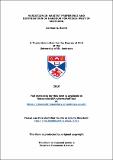Files in this item
Variation in habitat preference and distribution of harbour porpoises west of Scotland
Item metadata
| dc.contributor.advisor | Hammond, Philip S. | |
| dc.contributor.advisor | Gordon, Jonathan | |
| dc.contributor.author | Booth, Cormac G | |
| dc.coverage.spatial | 264 | en_US |
| dc.date.accessioned | 2011-03-18T08:46:35Z | |
| dc.date.available | 2011-03-18T08:46:35Z | |
| dc.date.issued | 2010-11-30 | |
| dc.identifier | uk.bl.ethos.552498 | |
| dc.identifier.uri | https://hdl.handle.net/10023/1701 | |
| dc.description.abstract | The waters off the west coast of Scotland have one of the highest densities of harbour porpoise (Phocoena phocoena) in Europe. Harbour porpoise are listed under Annex II of the EU Habitats Directive, requiring the designation of Special Areas of Conservation (SACs) for the species’ protection and conservation. The main aim of this thesis is to identify habitat preferences for harbour porpoise, and key regions that embody these preferences, which could therefore be suitable as SACs; and to determine how harbour porpoise use these regions over time and space. Designed visual and acoustic line-transect surveys were conducted between 2003 and 2008. Generalised Estimating Equations (GEEs) were used to determine relationships between the relative density of harbour porpoise and temporally and spatially variable oceanographic covariates. Predictive models showed that depth, slope, distance to land and spring tidal range were all important in explaining porpoise distribution. There were also significant temporal variations in habitat use. However, whilst some variation was observed among years and months, consistent preferences for water depths between 50 and 150 m and highly sloped regions were observed across the temporal models. Predicted surfaces revealed a consistent inshore distribution for the species throughout the west coast of Scotland. Regional models revealed similar habitat preferences to the full-extent models, and indicated that the Small Isles and Sound of Jura were the most consistently important regions for harbour porpoise, and that these regions could be suitable as SACs. The impacts of seal scarers on distribution and habitat use were also investigated, and there were indications that these devices have the potential to displace harbour porpoise. These results should be considered in the assessment of sites for SAC designation, and in implementing appropriate conservation measures for harbour porpoise. | en_US |
| dc.language.iso | en | en_US |
| dc.publisher | University of St Andrews | |
| dc.rights | Creative Commons Attribution 3.0 Unported | |
| dc.rights.uri | http://creativecommons.org/licenses/by/3.0/ | |
| dc.subject | Distribution | en_US |
| dc.subject | Habitat preference | en_US |
| dc.subject.lcc | QL737.C434B7 | en_US |
| dc.subject.lcsh | Harbor porpoise--Habitat--Scotland | en_US |
| dc.subject.lcsh | Harbor porpoise--Scotland--Geographical distribution | en_US |
| dc.title | Variation in habitat preference and distribution of harbour porpoises west of Scotland | en_US |
| dc.type | Thesis | en_US |
| dc.type.qualificationlevel | Doctoral | en_US |
| dc.type.qualificationname | PhD Doctor of Philosophy | en_US |
| dc.publisher.institution | The University of St Andrews | en_US |
This item appears in the following Collection(s)
Except where otherwise noted within the work, this item's licence for re-use is described as Creative Commons Attribution 3.0 Unported
Items in the St Andrews Research Repository are protected by copyright, with all rights reserved, unless otherwise indicated.


